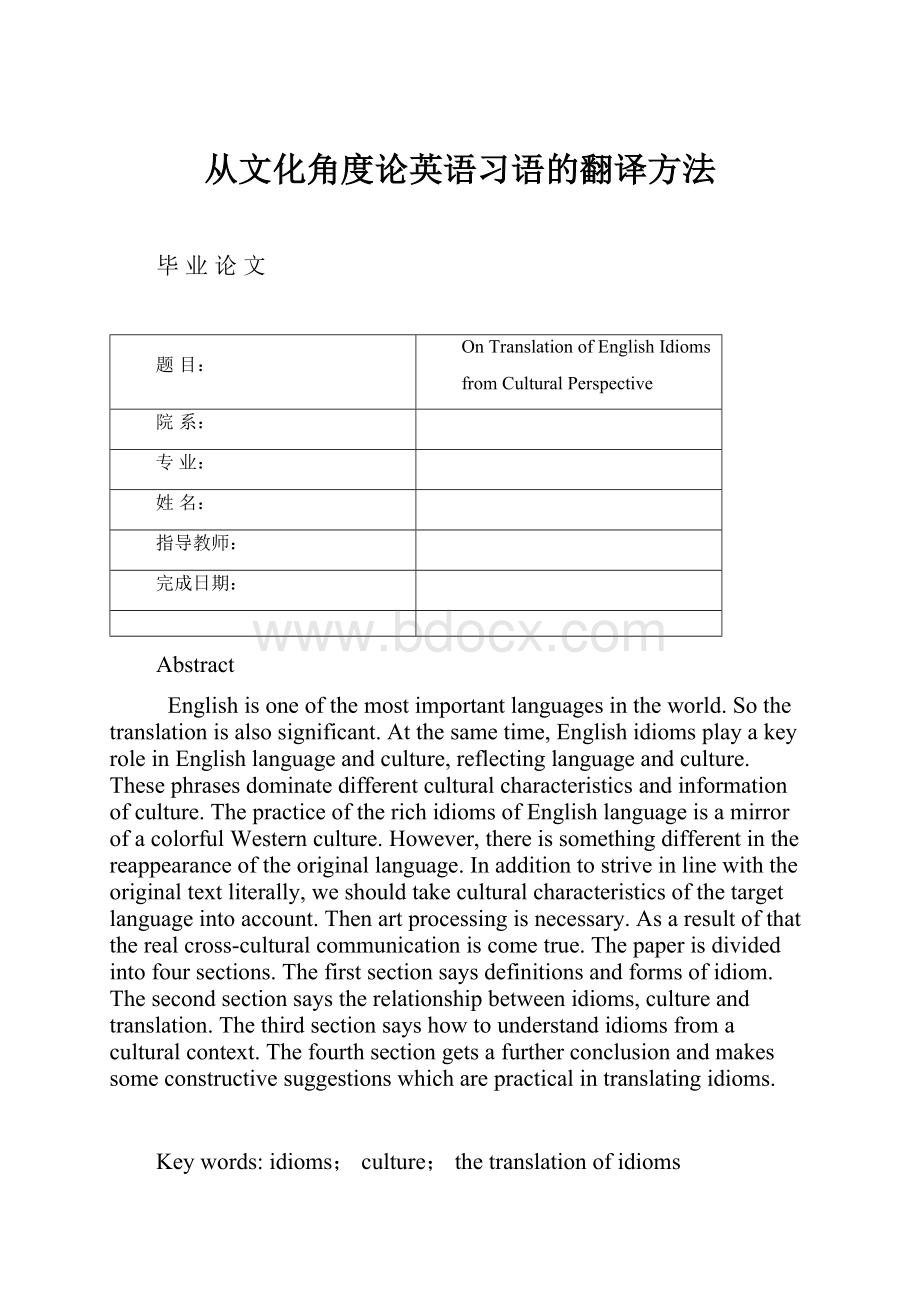 从文化角度论英语习语的翻译方法.docx
从文化角度论英语习语的翻译方法.docx
- 文档编号:9292611
- 上传时间:2023-02-04
- 格式:DOCX
- 页数:26
- 大小:41.87KB
从文化角度论英语习语的翻译方法.docx
《从文化角度论英语习语的翻译方法.docx》由会员分享,可在线阅读,更多相关《从文化角度论英语习语的翻译方法.docx(26页珍藏版)》请在冰豆网上搜索。

从文化角度论英语习语的翻译方法
毕业论文
题目:
OnTranslationofEnglishIdioms
fromCulturalPerspective
院系:
专业:
姓名:
指导教师:
完成日期:
Abstract
Englishisoneofthemostimportantlanguagesintheworld.Sothetranslationisalsosignificant.Atthesametime,EnglishidiomsplayakeyroleinEnglishlanguageandculture,reflectinglanguageandculture.Thesephrasesdominatedifferentculturalcharacteristicsandinformationofculture.ThepracticeoftherichidiomsofEnglishlanguageisamirrorofacolorfulWesternculture.However,thereissomethingdifferentinthereappearanceoftheoriginallanguage.Inadditiontostriveinlinewiththeoriginaltextliterally,weshouldtakeculturalcharacteristicsofthetargetlanguageintoaccount.Thenartprocessingisnecessary.Asaresultofthattherealcross-culturalcommunicationiscometrue.Thepaperisdividedintofoursections.Thefirstsectionsaysdefinitionsandformsofidiom.Thesecondsectionsaystherelationshipbetweenidioms,cultureandtranslation.Thethirdsectionsayshowtounderstandidiomsfromaculturalcontext.Thefourthsectiongetsafurtherconclusionandmakessomeconstructivesuggestionswhicharepracticalintranslatingidioms.
Keywords:
idioms;culture;thetranslationofidioms
摘要
英语是最重要的国际语言之一,因此翻译就变得很重要。
与此同时英语习语又是英语文化的重要体现,它反映了语言和文化特点。
这些习语承载了不同的民族文化特色和文化信息。
含义丰富的习语是多姿多彩的西方文化的一面镜子。
然而源于的再现是困难的。
为了再现原文的表现力,在翻译中,除了力求忠实原文,还应根据目的语的文化特点,对不同的源语言做相应的艺术加工,以真正实现跨文化交际。
本文共分为四大部分,第一部分是介绍习语的定义及形式;第二部分介绍了习语,文化和翻译之间的关系;第三部分讲的是如何在上下文中理解习语;最后一部分是作进一步总结以及一些实用的建议。
关键词:
习语;文化;习语的翻译
CONTENTS
Introduction1
ChapterOneDefinitionsandformsofidiom2
I.Thedefinitionsofidiom2
II.Formsofidioms4
1.Setphrases4
2.Allusions4
3.Proverbs5
.Slangs6
ChapterTwoIdioms,cultureandtranslation7
I.Idiomsandculture7
II.TheRelationshipbetweenIdiomsandCulture7
.Cultureandtranslation8
ChapterThreeUnderstandingidiomsfromaculturalcontext11
I.Theoriginalandnationalcoloring11
II.Theculturalloading13
ChapterFourthTranslationofIdioms15
.StrategiesforIdiomTranslation---DomesticationandForeignization15
.DialecticalRelationshipbetweenDomesticationandForeignization15
III.Translationmethodsofidioms17
1.Theliteralapproach17
2.Literaltranslationplusannotation18
3.Image-shifttranslation20
4.Theapproachofadditionandomission21
5.FreeTranslation---ReplacementwithSimilarChineseIdioms23
IV.ThePointsforAttentionintheTranslationofEnglishIdioms23
1.AvoidingWord-for-WordTranslation23
2.AvoidingSubstitutionwithaHighlyCulture-boundChineseIdiom24
Conclusion26
Bibliography27
Acknowledgements28
Introduction
Culturalstudieshaverecentlybeenpopularinthewest.AnddiscussingculturalstudieshasalsobecomeamainstreaminthecircleofpresentChinesecultureandacademia,especiallyinthefieldofliterarytheoryandcriticism.Consequently,inthewidescopeoftranslationstudies,therearesomescholarsbothathomeandabroadwhohavetriedtoproficientlyuseculturaltranslationstudiesininterpretation.Translationisconsideredtobeacross-culturalcommunication.Itinvolvesnotonlythetransferbetweenlanguages,butalsothetransferbetweencultures.However,thewaysofthinking,beliefs,attitudesandvaluesofdifferentculturesbothleadtofailuresormisunderstandingsincross-culturalcommunicationandconfusetranslationtheoristsandtranslators.
Anidiomisabeautifulgemofalanguage.Yetitisverydifficulttolearnandbeusedinaforeignlanguage.Generallyspeaking,theyareratherhardtounderstandfromthemeaningofindividualwords.ChineseandEnglishbothaboundwithidioms,whichhaverespectivecharacteristicsandfar-reachingmeaning.Especiallymanyidiomsbecharacterizedwithfiguresandstrongculturalflavors.Iftheyaretranslatedappropriately,theoriginalspiritandmeaningscanbepreciselyconveyed,simplyunderstoodandeasilyacceptedbythetargetlanguagereaders.Inaddition,theChineseandEnglishvocabulariescanprovideacompleteculturalvision.Ifthetwolanguagesaresodifferentinbackgroundsandcultureswitheachother,itisalwayscomplicatedtotranslateidiomsofonelanguageintoanother.Thispaperexplainsthecloserelationshipbetweenidiomsandculturetranslation,andtheissueofidiomtranslationisstudiedfromaculturalperspective.
ChapterOne
Definitionsandformsofidiom
Theword“idiom”hasseveraldefinitions.In“theChineseidiom”,itmaybedefinedas“thelanguageofapeopleoracountry”;or“adialect”asin“Cantoneseidiom”.Itmaypossessanothermeaning,accordingtoOxfordAdvancedLearner’sEnglish-ChineseDictionary,“phraseorsentencewhosemeaningisnotclearfromthemeaningofitsindividualwordsandwhichmustbelearntasawholeunit”.Thispaperdeeplyexplorestheseconddefinition,forthesecondmostsuitsthepurposeofthepaper.“习语”isequivalentfor“Idiom”inChinese,italsoreferstoakindofaphraseorsentenceformedbylongusage.Wecansumuptwobasiccriteriafromtheabovedefinitions.Theseareimportanttodecidewhetheranexpressionisanidiom(or:
习语)ornot.
I.Thedefinitionsofidiom
Firstly,sinceidiomsareestablishedandmadeupbylongpracticalusage,lexicacomponentsofanidiomisrelativelysteadytoahighdegree.Thereislittleornovariationinformofanidiomundernormalcircumstances.Generallyspeaking,anychangeinthecomponentswillresultinabsurditiesorevendeprivetheidiomsofitsoriginalmeaning.Thefollowingareabsolutelycannotdobyaspeakerorwriterwhousesanidiomunlessheorsheismakingajokeonpurposeorattemptingplayonwords:
a.Changetheorderofthewordsinanidiom(e.g.“atsevensandsixes”insteadof“atsixesandsevens”);
b.Deleteawordfromanidiom(e.g.“akettleoffish”insteadof“adifferentkettleoffish”);
c.Addawordtoanidiom(e.g.“Fewwordsarethebest”insteadof“Fewwordsarebest”);
d.Casuallyreplaceawordwithanother(evenwithasynonymousword)(e.g.“arottenhorse”insteadof“arottenapple”)
e.Changegrammaticalstructureofanidiom(e.g.“finebirdsaremadebyfinefeathers”insteadof“finefeathersmakefinebirds”).
AsusageofEnglishidiom,inChinesewecanonlysay:
“七上八下”not“八上七下”“无的放矢”not“无的放箭”,although“矢”and“箭”bothmean“arrow”.However,inspiteofwhathasbeenmentionedabove,sometimes,forthesakeofsarcasm,forthesenseofhumororforthesakeofstyle,wecancreatesomenewvariantsfromtheoriginalidiomsaccordingtoitsstructure.Butthesecreativevariantsaremakeshift,andmaynotbewidelyacknowledgedbypeopleasawhole:
(1)“Wisemenwillbewisemen”isfrom“foolswillbefools”
(2)“Bedressedtotheteeth”isfrom“tobearmedtotheteeth”.
SimilarlyinChinese:
(3)“一石三鸟”(toachievethreeaimsatonce)isanirregularvariantofthesetphrase“一石二鸟”(toachievetwoaimsatonce);
Sometimesforrhetoricalpurpose,anidiomcanbemadebriefwithonlythecorewordremained:
(4)“Hisaffairwasthelaststraw.”Inthissentence,“thelaststraw”isadaptedfromtheidiom“thelaststrawthatbreaksthecamel’sback”Now“thelaststraw”isequalto“thelaststrawthatbreaksthecamel’sback”.
(5)“Opportunitiesforstartingyourownbusinesswillneverbebetter,somakehayandgoandseeyourbankmanagertoday.”Here,“makehay”isshortenfromtheidiom“Makehaywhilethesunshines”.Suchabbreviationusuallydemandthefamiliarityoftheidiombythereadertoknowtherealmeaning.
Secondly,usuallythemeaningsofidiomscannotbeextrapolatedfromtheirindividualword.Moreoftenthannot,itcannotbetranslatedjustliterally.Ifitistranslatedaccordingtoitsliteralmeaning,therewillberidiculous.Taketheidiom“inDutch”forexample:
InsteadofintheNetherlands(Holland),itmeanstobedatedintrouble,asin“HehasbeengettinginDutchatschool.”ThenletustakeanotherChineseidiomforexample:
“放马后炮”(literallymeanstofireafirecrackerafterahorse.However,actuallyitmeanstodoanactionormakeanadviceaftersomethinghasbeendone).Anidiomusuallyexpressesandeepmeaning,inanotherword,mostidiomsaremetaphoricalinmeaning.Themeaningofanidiomisnotthetotalmeaningsofitsconstituentwords,thatistosay,idiomsconveyrighteranddeepermeaningasawholethantheindividualwordscancarryseparately.Thistheorycanbecompletelyillustratedbythefollowingexamples:
whenwethesolophrase”themaninthemoon”isnotanidiom.Butinafigurativesense,“themaninthemoon”referstosomeoneregardedasoutoftouchwithreallife.“Thecat’swhiskers”dosenotrefertoacat’sthickhairthatgrowsnearthemouth.Itreferstoanexcellentpersonorthing.“blackart”isnotanartisblackatall.Anditmeansatechniqueorpracticeconsideredmysteriousandsinister.
II.Formsofidioms
Broadlyspeakingidiomshavefollowingforms:
setphrases,proverbs,commonsayings,colloquialisms,allusionsandslangs.Herefourmostimportantformsareselectedtoexplain.
1.Setphrases
Oneofthemostimportantgroupsofidiomsissetphraseswhoseformisfixedandmanyofthemarenotflexibleandcannotbetakenplacebyanyotherforms.ThereisaninnumerablenumberofsetphrasesthatplayanimportantpartinEnglishlanguageandculture.Iwouldchooseoneofthemwithculturaltraces.Forexample,theoriginalmeaningof“tokickthebucket”canbedatedbacktoareligiousceremonyofbaptisminChristianity.Baptismisthereligiousriteofsprinklingwaterontoaperson’sforehead.AsfarasaChristianisconcerned,heorshehasthree
- 配套讲稿:
如PPT文件的首页显示word图标,表示该PPT已包含配套word讲稿。双击word图标可打开word文档。
- 特殊限制:
部分文档作品中含有的国旗、国徽等图片,仅作为作品整体效果示例展示,禁止商用。设计者仅对作品中独创性部分享有著作权。
- 关 键 词:
- 文化 角度 英语 习语 翻译 方法
 冰豆网所有资源均是用户自行上传分享,仅供网友学习交流,未经上传用户书面授权,请勿作他用。
冰豆网所有资源均是用户自行上传分享,仅供网友学习交流,未经上传用户书面授权,请勿作他用。


 《JAVA编程基础》课程标准软件16级.docx
《JAVA编程基础》课程标准软件16级.docx
